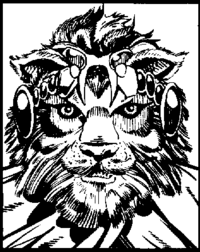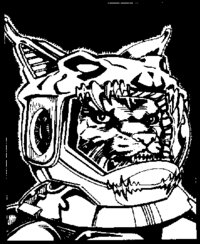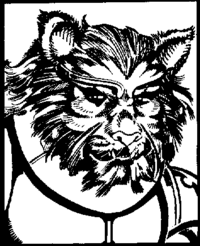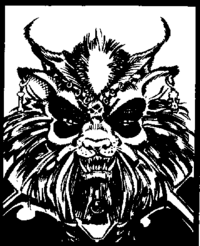Kilrathi: Difference between revisions
Aeronautico (talk | contribs) No edit summary |
(Attempted to make some sense of order out of a jumble of trivia points) |
||
| Line 4: | Line 4: | ||
[[Image:Cm-dakhath.png|thumb|200px|right|Dakhath nar Sihkag.]] | [[Image:Cm-dakhath.png|thumb|200px|right|Dakhath nar Sihkag.]] | ||
The '''Kilrathi''' are a race of felinoid, bipedal aliens | The '''Kilrathi''' are a race of sentient, felinoid, bipedal aliens from the planet [[Kilrah]]. They are a warrior race who inhabit the territories of the [[Empire of Kilrah]]. Without combat against external forces, the Kilrathi quickly fall into civil war and inter-clan warfare, as was prevalent before the Kilrathi gained interstellar flight. Kilrathi are naturally predisposed to attack over defense, and to ambush over attack–in-force. Kilrathi are most comfortable attacking in groups. In groups of three or more, Kilrathi warriors will often display suicidal courage and engage numerically superior forces. However, a lone Kilrathi (and sometimes a pair) will sometimes avoid contact, even against an evenly matched enemy. | ||
Kilrathi | Kilrathi are believed to have evolved from carnivorous pack-hunters, resulting in their belligerent and expansionist behaviour. They are natural guerrilla fighters. Proto-Kilrathi hunting packs would conceal themselves along known game-trails, lie in wait until a herd of food-animals passed by, identify the weakest, most vulnerable prey, and execute a co-ordinated attack. Kilrathi have been hunting in this fashion, using instinct and natural weaponry, for at least 10 million years. These pack-hunting tactics are very deeply ingrained in the Kilrathi psyche. Obviously, anything the Kilrathi instinct suggests, the Kilrathi intellect can overrule, but the pack-hunter paradigm is the one that comes the most naturally to the Kilrathi, and therefore the one they will turn to under stress, or when they believe they have the advantage. | ||
Physically, Kilrathi are around two meters in height and resemble Terran felines. Kilrathi are significantly stronger than [[human]]s, with a warrior being able to dead-lift about 700 kg overhead. Kilrathi have natural weapons in their teeth and claws. Kilrathi claws are capable of cleanly severing a human spinal column. | Physically, Kilrathi are around two meters in height and resemble Terran felines. Kilrathi are significantly stronger than [[human]]s, with a warrior being able to dead-lift about 700 kg overhead. Kilrathi have natural weapons in their teeth and claws. Kilrathi claws are capable of cleanly severing a human spinal column. | ||
Kilrathi society is built upon honour and the strength of the individual. The society is incredibly class based, with a nobility that holds absolute power over those below them | Kilrathi society is built upon honour and the strength of the individual. The society is incredibly class-based, with a nobility that holds absolute power over those below them. | ||
Kilrathi ship classes include the [[Salthi]], [[Dralthi]], [[Krant]], [[Gratha]], [[Jalthi]], [[Dorkir]], [[Ralari]] and [[Fralthi]]. Notable Kilrathi include [[Bakhtosh nar Kiranka]], [[Bhurak nar Caxki ]], [[Dakhath nar Sihkag]], and [[Khajja nar Ja'targk]]. | |||
The Kilrathi first came into contact with [[Terrans]] on [[2629.105]] in the [[Vega Sector]]. After first encountering the exploration ship [[TCS Iason]], the Kilrathi ship waited twenty minutes and then opened fire with all guns, utterly destroying Iason and all hands. | |||
Kilrathi | The [[Terran Confederation]] formally declared war on the [[Empire of Kilrah]] on [[2634.186]]. The first large-scale Terran-Kilrathi engagement occurred on 2634.235 when the Kilrathi Fleet launched an assault against the Confederation colony of McAuliffe and the space station Alexandria in orbit around it. On 2639.033 Kilrathi forces invade and occupy the Confederation world of [[Enyo]] marking the beginning of the [[Enyo Engagement]]. | ||
Kilrathi have a natural affinity for the ambush and sneak attacks. A lone Kilrathi is frequently a decoy planted to lure opposing forces into an ambush situation. Examples of Kilrathi sneak attacks are | Kilrathi have a natural affinity for the ambush and sneak attacks. A lone Kilrathi is frequently a decoy planted to lure opposing forces into an ambush situation. Examples of Kilrathi sneak attacks are clear with the events at [[McAuliffe]] and the [[Battle of Terra]]. | ||
Kilrathi will sometimes fixate on a wounded enemy, pursuing it to the death, while ignoring more dangerous, undamaged opponents. This happens enough that | Kilrathi will sometimes fixate on a wounded enemy, pursuing it to the death, while ignoring more dangerous, undamaged opponents. This happens enough that Confederation tacticians have dubbed it “blood frenzy.” | ||
Because of their affinity for group tactics, Kilrathi are not naturally prone to sabotage or spy operations involving the insertion and action of a single operative, although they have been known to do so on the rare occasion, generally using threats of force to coerce members of other races to spy for them. | Because of their affinity for group tactics, Kilrathi are not naturally prone to sabotage or spy operations involving the insertion and action of a single operative, although they have been known to do so on the rare occasion, generally using threats of force to coerce members of other races to spy for them. | ||
| Line 50: | Line 32: | ||
:Respond to the challenge | :Respond to the challenge | ||
Obeying one’s superiors without question is the most basic and pervasive social tenet of Kilrathi martial culture. Imagination and creativity are only encouraged in senior commanders and nobles. Line | Obeying one’s superiors without question is the most basic and pervasive social tenet of Kilrathi martial culture. Imagination and creativity are only encouraged in senior commanders and nobles. Line troops and commoners are trained to simply follow orders, specifically and without question or interpretation. The conceptual basis for this custom, it is believed, is the idea that a warrior given specific instructions can concentrate on fulfilling them, to the exclusion of other distractions, while a warrior given more general goals may become distracted by instinctive hunting behaviours to the detriment of the overall strategic mission. As a result, if an enemy makes the mission goals of a Kilrathi unachievable or logically impossible, the Kilrathi force will sometimes be thrown into complete chaos, particularly if not under the direct supervision of a dominant leader. | ||
Focusing on the strongest is the absolute opposite of the Kilrathi hunting instinct, which is to focus on the weakest prey. In warfare, however, it is inadvisable to leave the strongest opponents alive and capable of attack. As a result, the Kilrathi have made focusing attack on the enemy’s strongest asset first one of their primary tenets. | Focusing on the strongest is the absolute opposite of the Kilrathi hunting instinct, which is to focus on the weakest prey. In warfare, however, it is inadvisable to leave the strongest opponents alive and capable of attack. As a result, the Kilrathi have made focusing attack on the enemy’s strongest asset first one of their primary tenets. | ||
The necessity of responding to a challenge is an integral part of Kilrathi society. Any insult of challenge can be considered the grounds for a struggle to the death. It is, in fact, punishable by death for a warrior in the Kilrathi military to back down from single combat. Through challenge, the Kilrathi dominant/submissive relationship is established. This dominance and submission is the underlying basis of the entire Kilrathi social system, with the stronger Kilrathi having complete control over the actions and fate of those beneath them. A notable exception is that challenges by subordinates to superiors do not always have to result in a fight to the death, for varying reasons. A subordinate is, in many cases, honour-bound to follow the orders of his superior. Challenging his superior, except in extremely unusual | The necessity of responding to a challenge is an integral part of Kilrathi society. Any insult of challenge can be considered the grounds for a struggle to the death. It is, in fact, punishable by death for a warrior in the Kilrathi military to back down from single combat. Through challenge, the Kilrathi dominant/submissive relationship is established. This dominance and submission is the underlying basis of the entire Kilrathi social system, with the stronger Kilrathi having complete control over the actions and fate of those beneath them. A notable exception is that challenges by subordinates to superiors do not always have to result in a fight to the death, for varying reasons. A subordinate is, in many cases, honour-bound to follow the orders of his superior. Challenging his superior, except in extremely unusual situations, would be a violation of his oath, which is a great crime in a society built upon rules of honour. | ||
==References== | ==References== | ||
Source: [http://www.wcnews.com/encyclopedia/showrecord.php?id=1515 WC CIC Encyclopedia] | Source: [http://www.wcnews.com/encyclopedia/showrecord.php?id=1515 WC CIC Encyclopedia] | ||
[[category:races]] | [[category:races]] | ||
Revision as of 11:02, 21 July 2010
The Kilrathi are a race of sentient, felinoid, bipedal aliens from the planet Kilrah. They are a warrior race who inhabit the territories of the Empire of Kilrah. Without combat against external forces, the Kilrathi quickly fall into civil war and inter-clan warfare, as was prevalent before the Kilrathi gained interstellar flight. Kilrathi are naturally predisposed to attack over defense, and to ambush over attack–in-force. Kilrathi are most comfortable attacking in groups. In groups of three or more, Kilrathi warriors will often display suicidal courage and engage numerically superior forces. However, a lone Kilrathi (and sometimes a pair) will sometimes avoid contact, even against an evenly matched enemy.
Kilrathi are believed to have evolved from carnivorous pack-hunters, resulting in their belligerent and expansionist behaviour. They are natural guerrilla fighters. Proto-Kilrathi hunting packs would conceal themselves along known game-trails, lie in wait until a herd of food-animals passed by, identify the weakest, most vulnerable prey, and execute a co-ordinated attack. Kilrathi have been hunting in this fashion, using instinct and natural weaponry, for at least 10 million years. These pack-hunting tactics are very deeply ingrained in the Kilrathi psyche. Obviously, anything the Kilrathi instinct suggests, the Kilrathi intellect can overrule, but the pack-hunter paradigm is the one that comes the most naturally to the Kilrathi, and therefore the one they will turn to under stress, or when they believe they have the advantage.
Physically, Kilrathi are around two meters in height and resemble Terran felines. Kilrathi are significantly stronger than humans, with a warrior being able to dead-lift about 700 kg overhead. Kilrathi have natural weapons in their teeth and claws. Kilrathi claws are capable of cleanly severing a human spinal column.
Kilrathi society is built upon honour and the strength of the individual. The society is incredibly class-based, with a nobility that holds absolute power over those below them.
Kilrathi ship classes include the Salthi, Dralthi, Krant, Gratha, Jalthi, Dorkir, Ralari and Fralthi. Notable Kilrathi include Bakhtosh nar Kiranka, Bhurak nar Caxki , Dakhath nar Sihkag, and Khajja nar Ja'targk.
The Kilrathi first came into contact with Terrans on 2629.105 in the Vega Sector. After first encountering the exploration ship TCS Iason, the Kilrathi ship waited twenty minutes and then opened fire with all guns, utterly destroying Iason and all hands.
The Terran Confederation formally declared war on the Empire of Kilrah on 2634.186. The first large-scale Terran-Kilrathi engagement occurred on 2634.235 when the Kilrathi Fleet launched an assault against the Confederation colony of McAuliffe and the space station Alexandria in orbit around it. On 2639.033 Kilrathi forces invade and occupy the Confederation world of Enyo marking the beginning of the Enyo Engagement.
Kilrathi have a natural affinity for the ambush and sneak attacks. A lone Kilrathi is frequently a decoy planted to lure opposing forces into an ambush situation. Examples of Kilrathi sneak attacks are clear with the events at McAuliffe and the Battle of Terra.
Kilrathi will sometimes fixate on a wounded enemy, pursuing it to the death, while ignoring more dangerous, undamaged opponents. This happens enough that Confederation tacticians have dubbed it “blood frenzy.”
Because of their affinity for group tactics, Kilrathi are not naturally prone to sabotage or spy operations involving the insertion and action of a single operative, although they have been known to do so on the rare occasion, generally using threats of force to coerce members of other races to spy for them.
The Kilrathi are, of course, fully aware of these tendencies in their psyche as they have exploited them against each other in inter-clan warfare for millennia. As a race, they have developed numerous social constructs designed to bypass these racial tendencies when it is advantageous to do so.
These behaviours include:
- Obey without question
- Focus on the strongest
- Respond to the challenge
Obeying one’s superiors without question is the most basic and pervasive social tenet of Kilrathi martial culture. Imagination and creativity are only encouraged in senior commanders and nobles. Line troops and commoners are trained to simply follow orders, specifically and without question or interpretation. The conceptual basis for this custom, it is believed, is the idea that a warrior given specific instructions can concentrate on fulfilling them, to the exclusion of other distractions, while a warrior given more general goals may become distracted by instinctive hunting behaviours to the detriment of the overall strategic mission. As a result, if an enemy makes the mission goals of a Kilrathi unachievable or logically impossible, the Kilrathi force will sometimes be thrown into complete chaos, particularly if not under the direct supervision of a dominant leader.
Focusing on the strongest is the absolute opposite of the Kilrathi hunting instinct, which is to focus on the weakest prey. In warfare, however, it is inadvisable to leave the strongest opponents alive and capable of attack. As a result, the Kilrathi have made focusing attack on the enemy’s strongest asset first one of their primary tenets.
The necessity of responding to a challenge is an integral part of Kilrathi society. Any insult of challenge can be considered the grounds for a struggle to the death. It is, in fact, punishable by death for a warrior in the Kilrathi military to back down from single combat. Through challenge, the Kilrathi dominant/submissive relationship is established. This dominance and submission is the underlying basis of the entire Kilrathi social system, with the stronger Kilrathi having complete control over the actions and fate of those beneath them. A notable exception is that challenges by subordinates to superiors do not always have to result in a fight to the death, for varying reasons. A subordinate is, in many cases, honour-bound to follow the orders of his superior. Challenging his superior, except in extremely unusual situations, would be a violation of his oath, which is a great crime in a society built upon rules of honour.
References
Source: WC CIC Encyclopedia



